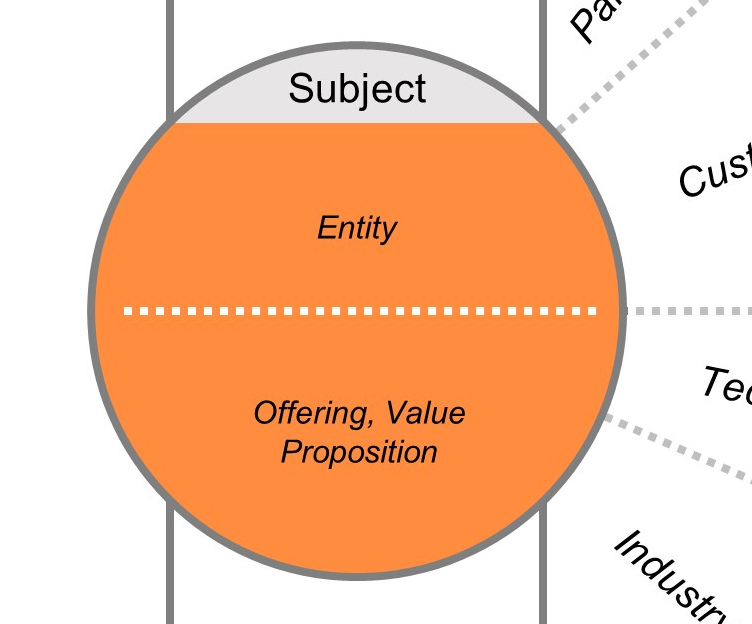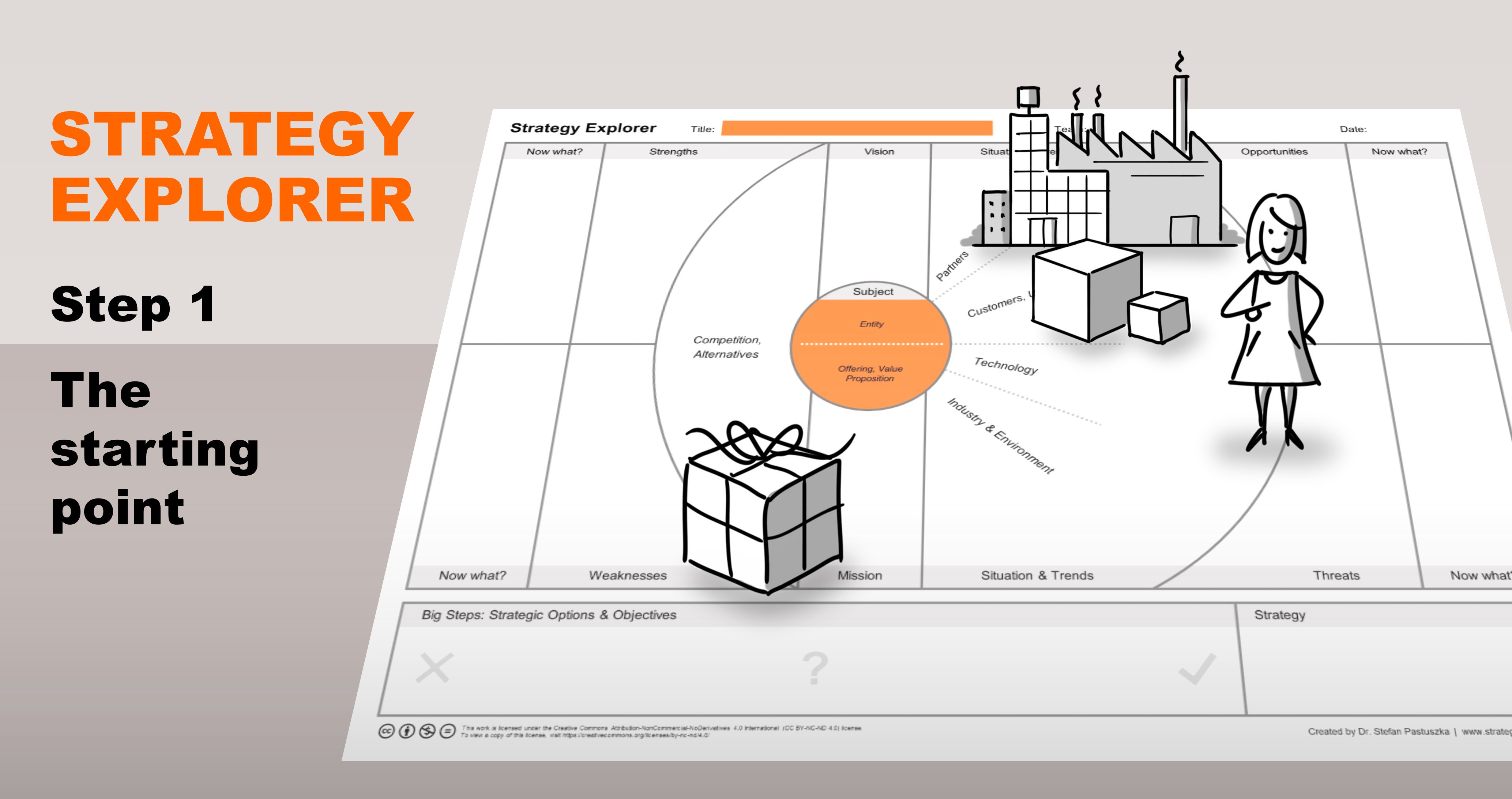Welcome to the first article in a small series on how to use the Strategy Explorer, my new canvas-based method for strategy development. As described earlier, the process of strategy development with the Strategy Explorer consists of six steps and this article will help you to get started and tackle the first one. Of course, the short articles cannot (and shall not) fully replace the book – which is why I recommend reading the book to everybody who wants to gain a deeper understanding and is adept in German language.
Let’s get going
Before starting your work, you obviously need the Strategy Explorer: visit www.strategy-explorer.xyz, download the template and print it in the appropriate format. Choose A4 or A3 if you want to work as an individual, or the B0 poster size if you plan to have a go at it with a team. You will find some practical tips for printing the template in poster size in the Blog section.
The first step in the actual work with the Strategy Explorer consists in finding a headline and defining the Subject at the heart of the strategy development. Both elements are important as they set the stage for all following steps and therefore have a strong impact on the outcome. Basically, it will be helpful to get clarity on the following three questions:
- Why do you want to develop a strategy,
- what do you aim to achieve in general, and
- what exactly do you want to development a strategy for?
The first question might be relatively easy to answer (maybe your company is facing difficulties in the market, fails to attract skilled workers, your products are being substituted, members are leaving your association, etc.) while the answer to the second might be a bit blurry (which would be OK at this stage in the process). The tricky part, however, could be the third question with an answer that might not be as obvious as expected. The insight you generate is condensed into the fields “Title” and “Subject” in the Strategy Explorer.
The title: find a proper headline!
Of course, a clear headline will help you invite colleagues to your workshop session. More importantly though, the formulation of a proper headline will help focus your work by capturing the core issue and motivation for the process. Therefore, the answers to questions one (why strategy development) and two (what to achieve) will certainly be instructive to find a suitable title for the Strategy Explorer you are going to fill out. Try to formulate it as concisely as possible. High precision is not needed at this point of time, as the headline shall only show the general direction of the strategy development process, without lining out detailed goals and the way to achieve them – these will be clarified later in the process.
Example: if you observe that your company is losing skilled workers to competitors and there are several indicators that this is due to poor working conditions, you might aim to make your company a more attractive employer. A headline in this situation could be “Making X an attractive employer” or “Increase employee attractiveness”. Of course, there might be other reasons why you lose employees, e.g. if they see that your business model is outdated and will become obsolete sooner or later. In such a case, the motivation and headline would be surely different, like “Making X future safe”.
If you do not wish to pre-empt the subsequent analysis and intend to stay maximally open-minded, choose a title which is more focused on the issue and less on a specific solution (like “Future Strategy for X”).
The Subject: what are you developing a strategy for?
 While you can well start your strategy development without a proper headline, the definition of the Subject is at the heart of the whole process, as already indicated by the central position of the field in the Strategy Explorer. As shown in the graphic, the Subject consists of an entity (= an organization, person, product, …) and its offering (= product, service, etc.) or value proposition (= problem solving, satisfying needs, etc.).
While you can well start your strategy development without a proper headline, the definition of the Subject is at the heart of the whole process, as already indicated by the central position of the field in the Strategy Explorer. As shown in the graphic, the Subject consists of an entity (= an organization, person, product, …) and its offering (= product, service, etc.) or value proposition (= problem solving, satisfying needs, etc.).
The definition of the Subject is critical as it will strongly influence the results of your strategy development. In case of an organization (e.g., company X), the offering or value proposition will determine who the competitors of company X are. Example: Company X is producing, say, electric drills. If the offering is just specified as “electric drills (production and sales)”, the company will be in competition with all other firms that produce and sell electric drills for its geographical market. If, in contrast, company X specifies a value proposition like “helping customers to get a hole into the wall”, the competition will look very different and include other players from different fields, like craftsmen or tool rental firms. At the same time, this definition will open the way to think much broader about the future development of the firm and will lead to many more options in the coming process. Typically, the value proposition of an organization is very close to its mission. So if you have a clear mission statement, it may help you derive the value proposition for the whole of the organization.
On a side note: Using the Strategy Explorer, you can also quickly develop strategies for hypothetical Subjects, in the form of “what if” scenarios. E.g., if you slightly tweak your existing situation (selling drills) to a potential new situation (helping to make holes), you can use the Strategy Explorer to map the changed environment and derive conclusions and promising courses of action (later steps in the process).
The Strategy Explorer is applicable for a variety of subjects and is not limited to companies. A subject at the center of the strategy development could also be other organizations (like associations), a person (e.g., for career development or freelance strategy), a product (go to market strategy) or even something as abstract as a process. The strategy development will work as long as there are alternatives and external factors outside your own control influencing the subject, see my previous article.
Be flexible
A clear understanding of the subject of your strategy development forms the foundation of all following considerations. It is also an excellent start for the discussion in the strategy team in order to be truly aligned.
However, if you get stuck in the discussion of the subject or experience difficulties in formulating a precise definition: move forward nonetheless. Try to go with the key principle of consent decision making: is the definition “good enough for now and safe enough to try”? If so, head on and revisit the subject later for more precise specification. In the following process of analysis, you may have new insights and will probably quickly gain the clarity you need. All steps in the Strategy Explorer process are reversible, i.e., it is fine (and sometimes even required) to jump forward and backward. At the end of the day, the full picture is more important than how straightforward you arrived there.
Just go ahead
If you already started with the first step, you may wish to continue with the next steps right away. In principle, the Strategy Explorer is almost self-explanatory and you can damage nothing by simply starting to work with it. So give it a try, wait for the next articles, or – if feasible – check out the book for quick instructions. If you already plan a workshop and need support, just give me a hint.
I wish you a good start with the Strategy Explorer! Feel free to let me know your experiences and also what you would like to read about the Strategy Explorer in my next articles.

